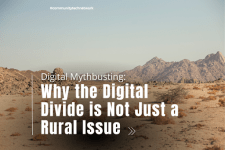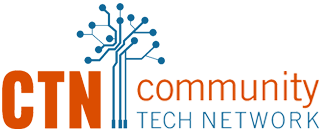The digital divide is a complex subject.
Earlier this year, we launched a Digital Mythbusting series, in which we dispel common misconceptions related to digital equity. Part one discussed why smartphones are not enough to bridge the digital divide.
Last month, we posted two new installments.

Myth: The digital divide only impacts rural communities.
Many people believe that the digital divide only affects remote, rural areas that lack adequate broadband infrastructure and strong internet signals. However, many urban neighborhoods, especially low-income communities, also face high levels of digital inequity. Learn more about the urban digital divide.
 Myth: The digital divide will solve itself over time.
Myth: The digital divide will solve itself over time.
Younger people are growing up with technology. Some six-year-olds are more tech-savvy than their parents! Thus, there is a commonly held belief that these younger generations will inherently possess the necessary skills to survive in our digital age. As they become the majority in the population, and older generations, who are less comfortable with technology, eventually phase out, the digital divide will be eliminated. Find out why this is a myth.
CTN SPOTLIGHTS

Volunteer Spotlight: Dee Davila began volunteering with CTN by hosting Q&A sessions in which they provided tech support for Spanish-speaking learners. Recently, they also hosted a successful webinar to teach older adults how to order groceries online.
“I was really happy for the learners,” says Dee. “They were engaged and interested and taking notes. That means that they valued the information enough to write it down and keep it with them. They have something that they can take back with them.” Learn more about Dee’s volunteer experience.
 Staff Spotlight: Uhunoma Edamwen has worked to address the digital divide from every angle: as a journalist, as a researcher, and even as a federal government official.
Staff Spotlight: Uhunoma Edamwen has worked to address the digital divide from every angle: as a journalist, as a researcher, and even as a federal government official.
When asked why he decided to join our team, he said that he wanted to work “more directly with the people,” as he believes that “community voices will shape digital equity in this decade” and that “CTN is on the frontlines of making change.” Read more about Uhunoma’s background and his role with CTN.
OTHER STORIES
- June was Pride Month! Don’t miss our blog which discusses the importance of digital access for the LGBTQ+ community, as well as the digital divide that many subsets of the community still face.
- As digital access has become a human right, learn about some strategies and initiatives that other countries, including South Korea, Estonia, India, and Uruguay, have successfully implemented to promote digital equity. Check out our blog called “Bridging the Digital Divide: A Global Perspective.”

Comments are closed.